The Gluten-Free Sourdough Bread Guide to help you make the best gluten-free sourdough of your life, with tons of tips, tricks, and techniques!!
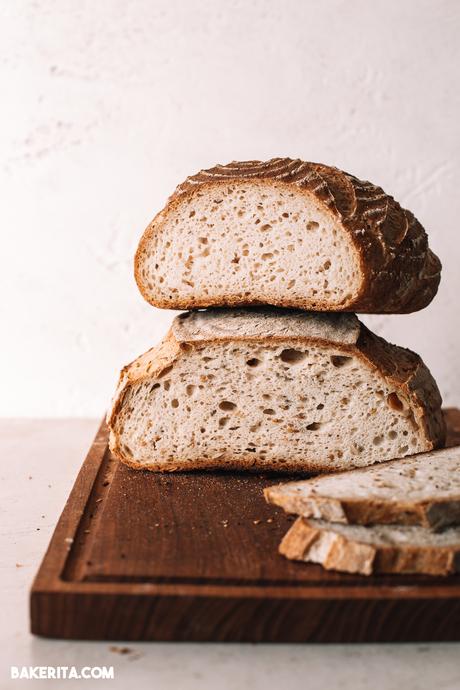
Never ever has a recipe been more requested, or gotten more testing from me. Gluten-Free Sourdough Bread is more than a recipe - it is a project. For gluten-free sourdough bread success, you must be committed time-wise and energy-wise. You must be willing to accept that it's going to take some time to figure out what works for YOU! One of my core beliefs with gluten-free sourdough is...
Making Gluten-Free Sourdough Bread is an intuitive practice.
YES, I recommend measuring everything out by weight, and following recipes exactly as you get started. There is a whole lot of science involved, but there are also SO many variables to consider.
Things like ambient air temperature, water hardness, and temperature, different brands of flours you're using, etc. It's easy to get wrapped up in the science, and that's a lot of the fun, but remember to also use your intuition. The farther along in the sourdough making process you get, the easier to understand it'll become. You'll feel more confident with each loaf.
I've heard from a lot of readers and Instagram followers about nervousness about making sourdough bread. As long as you're willing to commit the time, there's nothing to be nervous about. Everyone can make great bread.
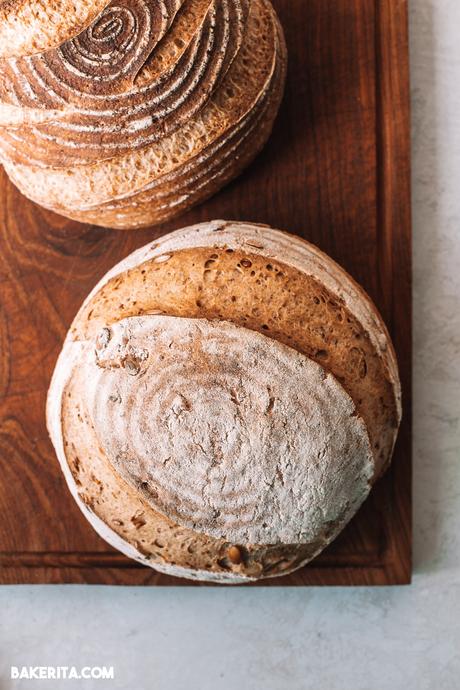
Now...should you choose to accept this mission, you will be greatly rewarded with fresh, golden loaves of heavenly gluten-free sourdough bread, perfect for toast, sandwiches, and garlic bread.
Before I get into this, I want to give credit where it is due: has been my favorite gluten-free sourdough guide, and a lot of what I learned is from her! This recipe and this recipe of hers are super informative, amazing recipes. There is also a group on Facebook called Gluten-Free Sourdough Bakers that is incredibly helpful for troubleshooting, sharing recipes, etc. I'll share even more resources for you to look through towards the bottom of the post. The more you know, the better you'll do, and I don't know everything! So, I like referring you to the people who know more than me for further learning! Alright - let's get into it.
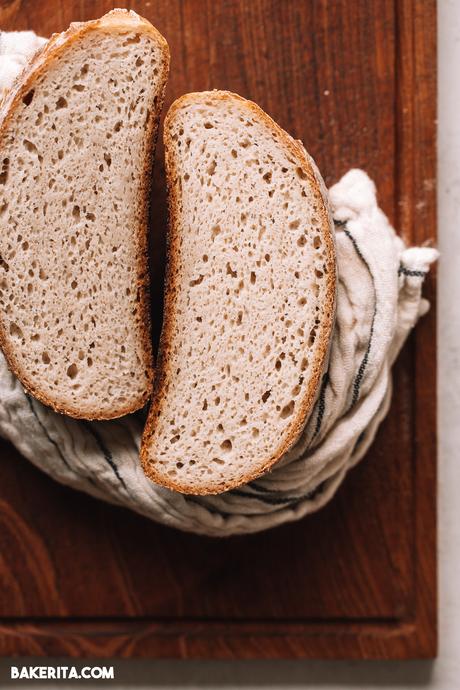
The Starter
This is the most important part of your bread. A healthy, happy starter is what will give you good bread. Without an active, happy starter, your bread will be dense and won't rise well when it hits the oven.
I feed my starter with brown rice flour, but you can use sorghum, millet, or most other wholegrain flours for your starter. I would not recommend using a premade gluten-free flour blend, or a starch. Wholegrains work best because they give your starter a lot to feed on. You can also use a combination of multiple flours to feed your starter, like half brown rice and half sorghum flour.
I will admit: I am kind of lazy with my starter, and don't use incredible precision with making sure it's 1:1:1 of starter:flour:water. I typically remove half of the starter (just eyeballing it), add between 100-125g of water, and then a slightly less amount of brown rice flour (between 100-115g).
The texture is key. When you mix up your starter, it should be a thick and pasty consistency. This will make sure your starter has enough flour to feed on and get you some good bubbling action.
You'll know your starter is ready to use when it doubles in size. You should see visible air bubbles. I keep a rubber band around my starter jar so I can see where it was when I first mixed up the starter, and can tell when it has doubled. You can also use a piece of tape to mark where your starter is right after mixing.
Don't compare your gluten-free starter to a gluten starter. Gluten-based sourdough starters are almost always more vigorous in their growth than gluten-free, and can sometimes even triple in size. It's doubtful your gluten-free starter will do that, so be patient with your starter. She's doing her best!
If you're not getting the rise you're looking for, try increasing your feeding schedule. Feeding twice in one day can supercharge your starter and make it very happy. If you're not seeing great growth, do two feedings, not too far apart, on bread baking day. This will make sure you're at peak activity.
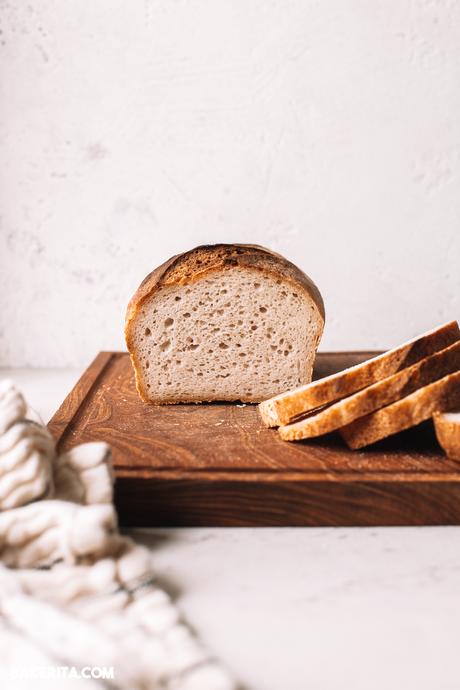
All about Psyllium Husk
Psyllium husk is our gluten for this bread: it provides the binding properties and elasticity that helps the dough become workable. It gives the structure and support for the bread to rise, as well.
Psyllium is a form of fiber that is derived from husks plantain of seeds . It has a lot of health and digestive benefits, but it's the gelling, fiber-filled aspects of the plant that we're after here!
From my experiments: you need psyllium husk for good gluten-free sourdough bread. For my bread recipes, I wouldn't try to replace it. Psyllium helps make the dough workable, so it doesn't squish and stick all over the place. It's also what makes your bread chewy and stretchy.
NOTE: psyllium husk and psyllium husk powder are different. You want the full husk. You can generally find it more easily anyways, but make sure you don't use the powder. It's much more absorbent and I have not tried it in my tests. I usually find it in the supplement area of most grocery stores.
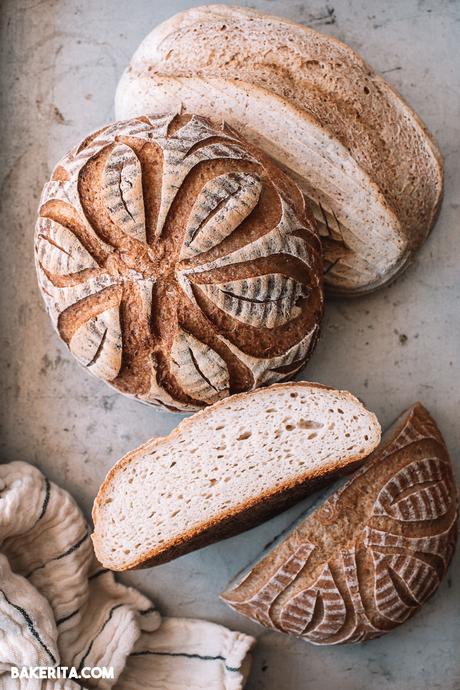
Picking your flour blend
These are the flours I use most for my gluten-free sourdough bread! I switch these up often, and I recommend you experiment with them as well, taking notes to see which combinations you prefer. I'll go into a bit more detail about this in the recipe itself.
- Brown Rice Flour: my original starter (used to make all the bread you see pictured) is made with brown rice flour, and it's a great staple for bread making. Make sure to source a superfine version of brown rice flour for the best results - a grainier flour will make a difference.
- Sorghum Flour: this is my MVP! I love the texture sorghum flour creates. It's a mild, smooth-textured flour. It also has nutritional benefits: it's high in fiber and filled with antioxidants, as an extra bonus.
- Millet Flour: millet flour adds a slight cakiness and sweetness to the bread, so I don't recommend using a huge amount of it. It can also give your bread a slightly creamy, yellowish tint. It's personally not my favorite flour, but it makes for a great texture. My dad, for instance, always LOVES my millet bread. Fun to play around with! Also loaded with good nutrients.
- Quinoa Flour: I find quinoa adds a little extra sour flavor that I love, makes for a fabulously textured bread too! The more I use quinoa flour, the more I like it! A great one to experiment with.
- Potato Starch (not flour): the potato starch you're after is snow white and super powdery. It adds tons of lift to your bread and balances out the whole grains, so your bread isn't too dense and heavy.
- Tapioca Flour or Arrowroot Flour: these are interchangeable, and work with the potato starch to add a lightness to your bread.
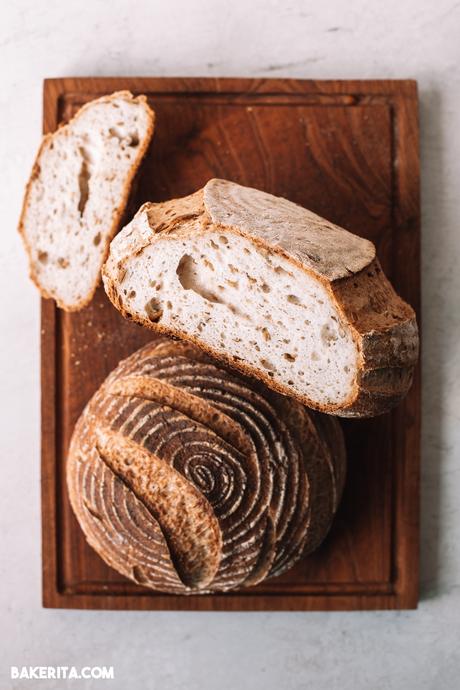
The Ratios of Sourdough
You'll hear people saying things like "100% hydration" or "85% hydration" when talking about sourdough.
What they are talking about when they say this is the ratio of flour to water. So, if a loaf is 100% hydration, then the ration of flour to water is 1:1.
I would recommend not getting too caught up in hydration ratios. I mostly ignored them while I learned all about sourdough, and that works well for me. The only time I really refer to them is when talking about my starter, which I feed with about 100% hydration. All this means is that you're feeding 1 part starter to 1 part water to 1 part flour.
Gluten-free flours vary far more widely in absorbency than traditional all-purpose flour does, which means it's more important to look out for the right consistency in gluten-free sourdough starter, rather than precisely the right ratio. Many times with my gluten-free flours, I find I need more water than flour because the flour is so absorbent.
Bread baking terminology
Preferment / Levain: both terms are interchangeable. The preferment (my preferred term, and what I'll use for the rest of this post) is a mixture of starter, water, and flour that will be the base of your bread. You'll take the starter at peak activity and mix it with water and flour, and allow that to rise and ferment. How long this ferments will impact how sour your loaf is.
Proofing: this is your bread rise after you shape the loaf. Some bread recipes do two rises, but I only do one, especially since we do a preferment with the starter.
Banneton: this is a basket, typically made of rattan, that you'll use for proofing your bread. It has better airflow than say, a bowl with a tea towel liner, which allows your bread to rise a little better. You do not bake in this basket. You also do not need one, but they are nice to have!
Scoring: this refers to the cuts you make on your bread before it goes into the oven, which allow the steam in your bread to escape. If you don't score your bread, it will crack on it's own to release the steam. By making your own cuts, you control where that steam escapes and allow the bread to rise in the oven more evenly.
Lame: typically used for scoring your gluten-free sourdough bread, it's just a razor blade used specifically for bread! It's usually attached to a handle of some sort.
Oven Spring: this is the rise that happens right after your bread hits the oven, and it's often helped along by preheating your Dutch oven in the oven to a high temperature before adding the loaf.
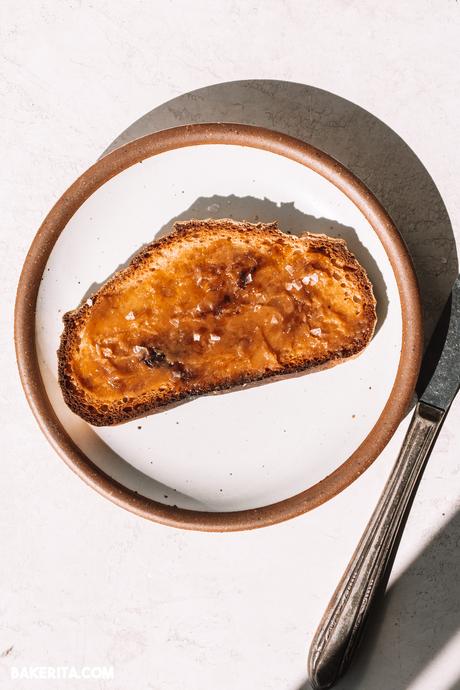
The tools you'll need to get started:
- A happy starter: you want peak activity (doubling after each feeding) before you start baking.
- Banneton: you can also use a bowl lined with a clean cloth tea towel, but bannetons do give you beautiful ridges and provide a great environment for your bread to rise.
- this is a razor blade you'll use for scoring your bread before baking. A sharp knife will work well too. My lame is from Wire Monkey Shop.
- Stand Mixer: this is optional - I've made many loaves using a bowl, a wooden spoon, and my hands. But if you have one, making bread using your stand mixer and a dough hook makes things super easy.
- Dutch Oven: you don't need a Dutch oven per se, but it definitely helps: the lid traps the heat and steam, and it helps provide a wonderfully crunchy crust. By preheating the Dutch oven, it also helps support your bread's lift once it hits the hot oven. I have a pricey Staub dutch oven that I've had forever, but more affordable options also work just as well.
- Parchment Paper: I find parchment tremendously useful for making a "sling" to help lower your bread into the Dutch oven, so it doesn't lose its rise from getting "dropped" into the Dutch oven, which can deflate the loaf. If you're really invested in bread making, you may want to invest in something like this silicone baking mat that's perfect for lowering and lifting your bread into the Dutch oven.
Loaf Shapes!
The classic round sourdough bread you're probably thinking of is called a boule. It's generally proofed in a banneton basket, or in a cloth-lined bowl, and then baked in a Dutch oven. But, why stop at round loaves?!
I love making this recipe in a classic loaf pan to get beautiful sandwich slices, and I also love making baguettes with this same recipe by just shaping differently and baking in a baguette pan. You can also get an oval-shaped banneton to make longer, more oval-shaped boules.
If you're going to bake in any other pans, I recommend using metal. It will conduct heat a lot better than a silicone or glass pan, and will help get crispy bottom and sides to your loaf.
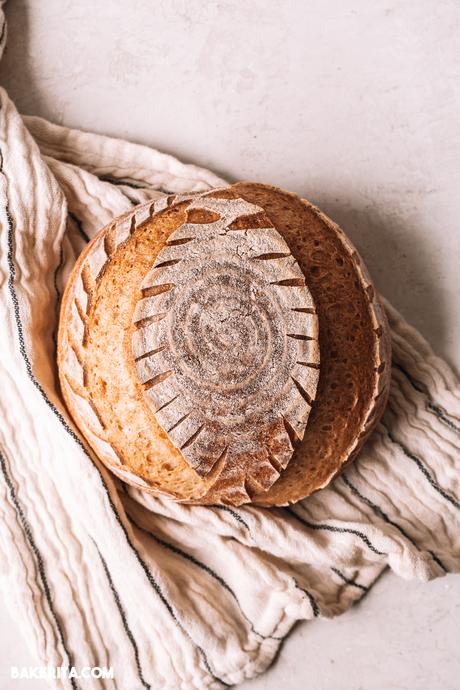
Getting your starter ready for baking
You'll want your starter to be at peak activity when you mix up your preferment! You also want to make sure you have enough starter for your loaf, and to make your bread. So, before making bread, I like to do a big feeding (about 150g each water and flour) and get to a solid doubling in size of my starter.
If your starter had been in the refrigerator, you want want to do two feedings before making brea to make sure your starter is super happy and ready to go!
How to make gluten-free sourdough bread
First things first - let's start with the preferment. That term refers to the initial mixing of active starter, flour, and water. It's essentially a feeding of just the starter you'll be using for the bread. The preferment can "proof" or activate anywhere from four hours to 18 hours. The length of fermentation will impact the level of sourness that your bread will have. A shorter ferment will lead to a less sour loaf. A longer one will give you a stronger sour flavor.
Once your preferment is bubbly and ready to bake with, it's time to mix up the dough for our gluten-free sourdough bread! Here is the process, in order, of how I make the bread dough:
- Mix the psyllium husk, sweetener, and water. Whisk until combined and let gel while preparing the flour mixture.
- In a large bowl or stand mixer, combine all of the flours + starches, plus salt. This is also where you're adding any herbs and other dry seasonings you may want to add.
- Whisk the psyllium gel mixture into the preferment, along with the olive oil if using. This is also when you'll add any other wet seasonings (like garlic, soaked nuts or seeds, etc.).
- Add the wet ingredients into the flour mixture. Use a spoon and then your hands to bring the dough together. You can also use your dough hook to mix all of the ingredients until a smooth dough forms.
- Once your dough is soft and smooth, turn it out onto a clean, smooth work surface. Knead into a smooth ball, and use your hands to shape the dough into a round (or whatever shape you're making).
- Use a dough scraper or your hands to transfer the dough into your banneton, or a bowl lined with a clean tea towel. Put the smooth side facing down, so the "seams" of the loaf are facing up. Since we'll flip the loaf before baking, the seams will be on the bottom after baking.
- Cover, and let the dough proof for about three hours at room temperature, or overnight in the refrigerator.
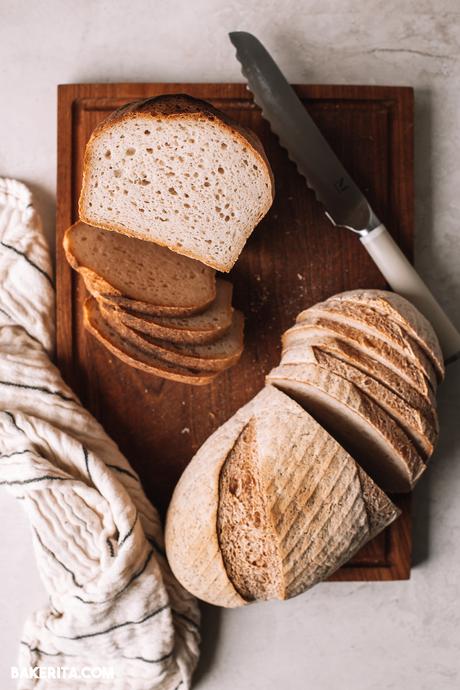
All about proofing
Proofing, scientifically, is a rest period after putting together your bread dough where the yeast ferments the dough and produces gases, which create the bubbles you see when you slice into a loaf of bread.
Proofing is SO location and temperature-dependent. In my steady San Diego climate, a 3-hour proof works pretty consistently for me - maybe a little longer in the winter, and a little shorter in the summer, due to ambient temperature. You can also proof your loaf overnight in the refrigerator, which also helps develop a more sour flavor!
If you live somewhere very warm and humid, your proofing time will be shorter. Perhaps your loaf is proofing too quickly - then you'll want to decrease the amount of starter to give your bread enough time to proof and develop without overproofing.
If you're in a cool place, or your starter is new and not very active yet, you'll want to add a higher amount of starter and/or let the bread proof longer.
You'll know your bread is well proofed when it seems to have increased in size - not quite doubled, but almost. When you press it, it should feel soft and airy and should spring back quickly. It's hard to describe the exact feeling, but after baking a few loaves, you'll get a feel for what a well-proofed loaf feels like!
If your bread is over-proofed: you'll see a big hole at the top of your loaf, between the crust and the rest of the loaf, and it will likely be dense and gummy at the bottom, where the dough started to settle. To fix an over-proofed loaf (before it goes into the oven), you can punch it down, knead it and shape it again, and allow it to rise a second time.
If your bread is under-proofed: you'll barely have any bubbles and your bread will be dense and gummy.
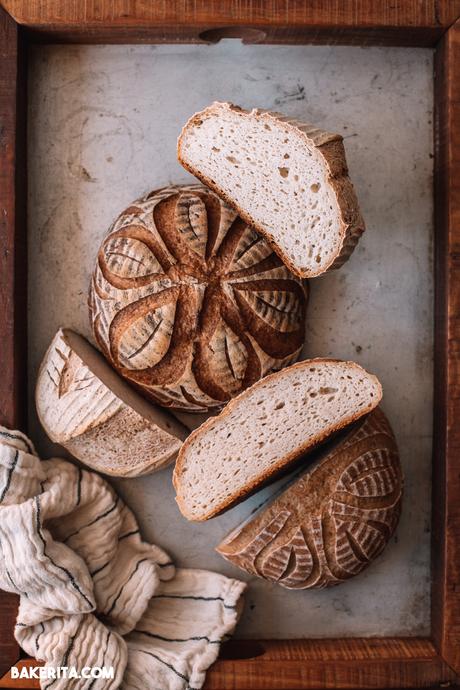
When you're ready to bake...
An hour before your gluten-free sourdough bread is ready to go into the oven, preheat your oven to 425°F/218°C. If you'll be baking in a Dutch Oven, allow it to heat inside of the oven. This will help you get a good oven spring with your loaf.
You can also bake on a preheated baking sheet, if you don't have a Dutch oven, or if you're doing a bread shape that doesn't fit into your Dutch oven.
TIP: If you're a slow mover when getting your bread into the oven, preheat to 450°F so you don't lose too much heat with the open oven, and once your bread is in, lower to 425°.
Baking time!
When your oven is preheated and your dough is well proofed, it's time to score your bread. Scoring is creating cuts in your bread that will direct the bread's rise, so instead of the bread rising and cracking on it's own, you can create some beautiful shapes and designs. Make sure your cut is deep enough, otherwise you'll still have cracking where you didn't cut through.
To score, you'll flip your bread out onto parchment paper or a silicone sling. Then you'll score your bread as desired. Remove your hot Dutch oven, carefully, from the oven. Carefully lower your loaf into the Dutch oven, being careful not to drop it, which would pop some of the air bubbles you've worked so hard for!
Replace the lid, and put your bread into the oven for 45 minutes. After 45 minutes, you'll remove the lid and let it finish baking for 25 to 40 minutes - exact timing will depend on your oven and how golden brown you want your bread.
When the bread is baked to your liking, very carefully remove it from the oven and let it cool completely.
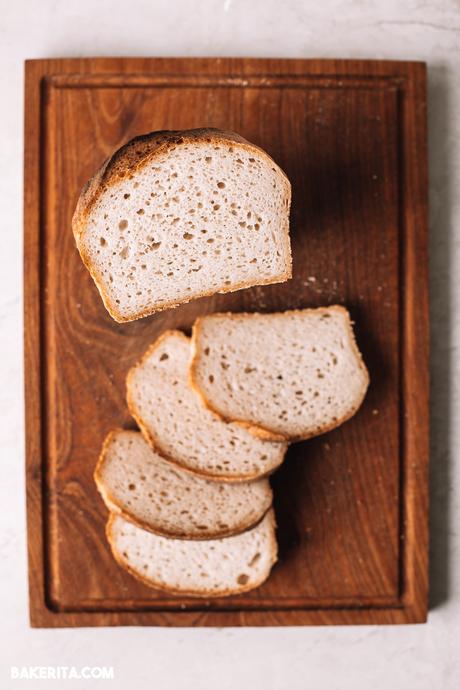
Your sourdough baking schedule
This gluten-free sourdough bread isn't particularly hard to make, but you do have to follow its schedule for the best results!! Here's a sample schedule of bread baking.
5:00pm: feed your starter a big feed to get it super active.
8:00pm: your starter should be at or close to peak rise. Once it is, mix up your preferment. Cover, and let it ferment overnight.
8:00am: mix up your bread dough. Place into your proofing basket or lined bowl and allow it to rise for three hours.
10:00am: preheat your oven with the Dutch oven inside of it, an hour before we're ready to bake.
10:55am (or whenever your bread is fully proofed): carefully flip your proofed bread out onto a sheet of parchment paper. This will help us move it into the hot Dutch oven). Score your bread as desired.
11:00am: remove the Dutch oven from the oven, carefully! Close the oven to not let the heat out. It will be very hot. Take off the lid, and carefully lower your bread into the hot Dutch oven. Be very careful not to drop it in, or you'll deflate the bubbles that you worked hard for! Put the lid back on, place back into the oven, and set your timer for 45 minutes.
11:45am: after 45 minutes of baking, quickly and carefully remove your the lid, and close the oven back up.
12:30pm: Bake for another 25 to 45 minutes. This will depend on your oven! Bake until the bread is golden brown, before removing it from the oven. If you can safely and carefully remove it from the Dutch oven, check the loaf by tapping or knocking on the bottom of the loaf. It will sound hollow when it's done!
Let it cool completely before you cut into it. Honestly, this is the hardest part, but if you cut into it too early, you'll release all the steam inside of the bread and it will get weird and gummy. Please use all your willpower to refrain!
This schedule can of course be adjusted. I've done it all in one day, starting early in the morning, but I wanted to share a sample schedule so you can visualize how long things take!
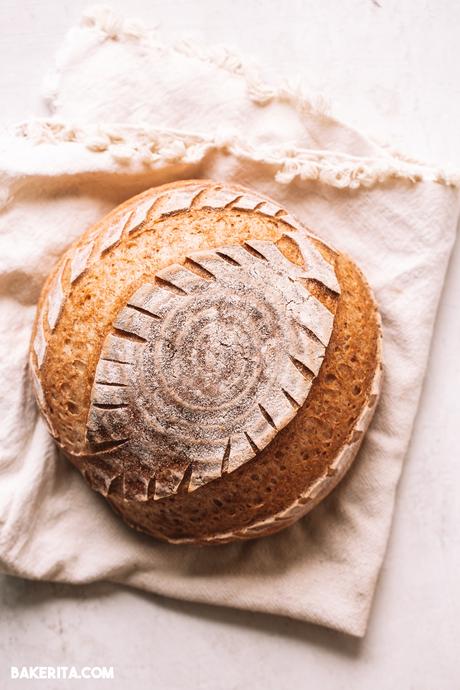
My bread is too sour/not sour enough - help!
The sourness of your gluten-free sourdough bread can vary based on a few factors, but time is the most important one! The longer your bread has to ferment (in the preferment and the rising time), the most sour your bread will be.
If you want your bread to be MORE sour: the easiest way to make it more sour, in my experience, is to let your preferment ferment for longer. I've done 16-ish hour ferments with the preferment and have gotten a pretty sourd loaf that way.
You can also use less starter in the bread, and let it rise for longer. Less starter will slow the ferment, so instead of the three-ish hours my proofing usually takes, yours may take 4 or 5 or even 6 hours, depending on the amount you used. You can also do a refrigerated proof overnight in the fridge to develop flavor. Just be careful not to overproof when you're trying this. It will lead to a dense bottom and a cavernous top.
Alternatively, you can add a little extra tang and help your rise a bit by using a teaspoon of apple cider vinegar in your bread dough.
This article from Homestead & Chill is not specifically for gluten-free sourdough. But, it has lots of helpful tips and science-y info for how to make your sourdough starter more sour.
If you want your bread to be LESS sour: I find this recipe isn't too sour, so I doubt you'll have this issue. If you do, you'll do just the opposite of above! Use a little bit more starter (not too much, your bread still needs time to rise and you don't want it to go too quickly) and don't let it proof for too long.
Help - my bread is gummy inside!
Chances are, one of the following is the case:
- You didn't cook it long enough
- There was too much liquid
- You cut into the bread too early, or accidentally broke the crust somehow while it was cooling
- The bread dough was dropped into the Dutch oven too hard
Make sure to be aware of all of these!! I found that under baking was the case whenever I had gumminess. Don't be afraid of a longer bake - the outside may seem dark, but I promise the inside won't overcook!
More Gluten-Free Sourdough Bread Resources...
I'm sure I will be adding to this post, and will also be creating a gluten-free sourdough bread Q&A page of my own, so feel free to reach out about questions/concerns you have, either below in the comments section, or on my Instagram. The goal is to have everyone making amazing gluten-free bread!!!
